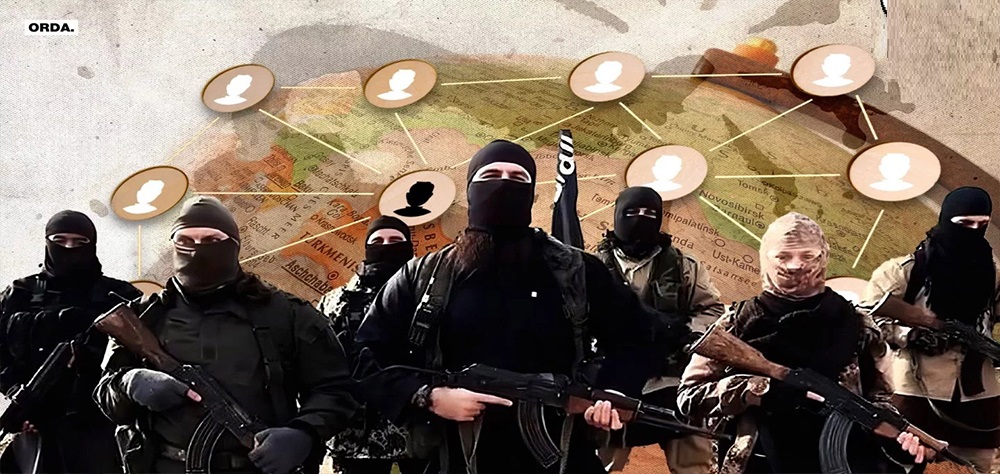After the terror attack of the ISIS-Khurasan on the Moscow concert hall on March 22 that killed 22 civilians, this terrorist group rapidly stepped up its media activity across Central Asia. Since March, several plans for attacks across Eurasia by the group's elements were detected and neutralized by intelligence agencies of regional countries. The media propaganda of this group now raise concerns about possible repeat of Syria and Iraq tragedies in this region in the years to come.
Many of militants involved in ISIS-Khurasan attacks of recent years are Central Asian nationals, mainly Tajiks. Still, little focus and attention is put on this growing threat despite the fact that a majority of the group's members are citizens from Central Asian states.
In the past months reports of arrests of members of this group in regional countries bore witness to the fact that the group is growing in the region. For example, later in December 2023, two teenagers were arrested in Jalal-Abad, Kyrgyzstan after security forces discovered their plans for carrying out several attacks. A few months later, a car blast in Tajikistan was described as a terrorist attack and linked to ISIS-Khurasan.
In mid-June, the National Security Committee of Kyrgyzstan detained 15 on charges of links to ISIS in the capital Bishkek and elsewhere. The suspects were accused of publishing videos on the Internet about training on the tactics of using weapons and explosives. The arrests came as it was announced that Kazakhstan had destroyed a terrorist cell that was planning to attack a Western target.
These developments indicate an alarming expansion of ISIS regional influence that is accompanied by extraordinary propaganda tactics on social media platforms for audience in Central Asia.
In 2022, the group launched its official media branches in Tajik and Uzbek languages under Al-Azeem name to produce hate content. In addition, ISIS now has an active Russian-language arm and continues to find new means of conveying its message, as it published a new Tajik-language magazine shortly after Moscow attack.
ISIS continues to use its old methods of recruitment and propagation of radicalism in Central Asia, most important of which is labeling the national governments of these states as puppets of the Western infidel powers and anti-Islamic powers. This group describes relations of Dushanbe and Tashkent with Moscow as a servant-master relationship aimed at promoting communism and uprooting Islam in these countries.
Using media propaganda and launching noisy terror attacks, ISIS seeks belligerent saber-rattling to introduce itself the only avaliable means for the proponents of takfiri ideology for challenging the national governments and perhaps revival of the Islamic caliphate.
As part of this strategy, ISIS has waged fight against Ansarullah, Turkistan Islamic Party, and other takfiri and radical militias. It names itself the powerful alternative to all these groups in hope of faster recruitment and fundraising.
Regional initiatives for confrontation of extremism
The extensive propaganda activities of ISIS have sounded the alarm for regional governments, especially that rooting of the branch of ISIS in Afghanistan, a country that is a gateway to Central Asia, can make the transfer of terrorists much easier than in the past, and they return to their hideouts in Afghanistan after doing terror actions and sabotage.
These terror actions and threats have pushed Central Asian states to initiate social integration and preventive measures beside or even before military and security responses.
According to The Diplomat website, up to March, over 2,100 members and families of takfiri fighters in Syria, Iraq, and Afghanistan have been expatriated to their home countries by Central Asian-organized humanitarian missions. Kazakhstan expatriated 754, Kyrgyzstan 511, Tajikistan 334, and Uzbekistan 531 to their countries.
After the return, these people, who are mostly women and children, undergo a rehabilitation process for their peaceful reintegration into their families and communities. Each country develops its own program and then shares its experiences on a regional scale for all beneficiaries.
For example, Uzbek President Shavkat Mirziyoyev proposed the formation of a regional expert council composed of leading experts from Central Asian countries under the auspices of the United Nations Office of Counter-Terrorism. The main purpose of this specialized regional council is strengthening regional and national initiatives for the rehabilitation and reintegration of people returning from conflict zones and to formulate strategies to fight terrorism.
This proposal was made during the high-level international conference on regional cooperation of Central Asian countries in the framework of the joint action plan for the implementation of the UN global strategy against terrorism on March 3-4, 2022 in Tashkent.
Despite these initiatives and measures, expansion of
radicalism in Central Asian countries should be followed with high
international sensitivity, especially that there is the risk of the
takfiri groups being instrumentalized as pressure levers against the
rivals in geopolitical competitions. Moscow, for instance, several times
noted that ISIS attacks on Russia are a product of schemes of
Intelligence agencies of Ukraine and its Western partners.
/129

